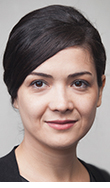Project to focus on developing new concrete casting technique

Negar Kalantar
Envisioning cityscapes renewed with stylish, custom-designed concrete structures, a group of Texas A&M design and engineering faculty and students will collaborate during the 2017-18 academic year to develop a low-cost method for quickly casting complex, concrete forms.
The $28,000 project is one of 16 funded by [AggiE_Challenge] (https://engineering.tamu.edu/easa/areas/enrichment/aggie-challenge) , a College of Engineering program that sponsors undergraduates in multidisciplinary team projects who address engineering-related problems.
The project is a response to a [grand challenge] (http://www.engineeringchallenges.org/challenges/infrastructure.aspx) issued by the National Academy of Engineering to restore and renew urban infrastructure. The challenge addresses a decades-long lack of aesthetic concern for urban infrastructure design and its impact on a city’s appearance and the cultural environment.
“Bridges, buildings, and even freeways contribute to the aesthetic appeal of a city, and care in their design can contribute to a more enjoyable urban environment,” states the NAE challenge.
The project design and engineering group, which includes Negar Kalantar, assistant professor of [architecture] (http://dept.arch.tamu.edu/) , aims to design and fabricate a prototype of a machine that can essentially “freeze” a polymer — a substance containing organic and synthetic materials — into an easily reusable, reconfigurable, transportable, no-waste mold for casting complex concrete building elements.
The group plans to fabricate the machine in Texas A&M’s [Engineering Innovation Center] (http://engineering.tamu.edu/easa/areas/enrichment/eic) , which features the latest protoyping equipment, tools, material and support staff.
“Our goal is not only to develop a way to incorporate beauty into renovations, but to create a low-cost casting method not restricted to just a few marquee buildings, but applicable to structures throughout the urban landscape,” said Kalantar.
The project’s solution will draw from a wide range of skills, including architectural and graphic design, geometry, manufacturing, and mechanical and civil engineering.
Faculty partnering with Kalantar on the project include Anastasia Muliana and Arun Srinivasa, from the Department of Mechanical Engineering, and Dinakar Sagapuram , from the Department of Industrial and Systems Engineering, who are recruiting students in their respective disciplines.
Richard Nira
rnira@arch.tamu.edu
Previous post
Tags
- academics
- architecture
- fabrication
- feature
- interdisciplinary
- partnerships
- studio projects
- technology
- undergraduate work
Related Posts

Collaboration yields kinetic installation for Bright building
Art and technology merge in students' design exploration

'Ranch' staff preps winning Aggie car

Colorful installation gives cafe a facelift
Follow Us
Facebook Twitter Vimeo Youtube Flickr RSS
Recent Posts

Planning prof heads study of disaster housing aid

A message from the dean

Former student remembered as expert planner

Leading educator named new head of Architecture Dept.





_thumbnail_small.png)
